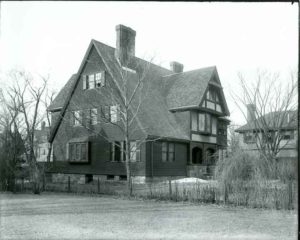“Renovising”
Introduction | Family and Early Life | At “The Tech” | A Woman-Owned Firm | Original Designs | “Renovising” | Howe and Her Community | Interactive Map | Works Cited | Other Links and Resources
Most of Howe and her collaborators’ projects in Cambridge consisted of additions or renovations to existing homes. Here again, Howe’s detailed knowledge of local architectural styles and history were crucial. Given that her clients loved their antique homes, Howe knew that despite her architect’s desire to open up interior spaces, to design more contemporary living arrangements, and to use sturdier and more attractive modern building materials, she would need to integrate these needs with original decorative and stylistic touches (Howe regularly recycled scraps from old buildings) throughout. Eleanor Manning named this process of integrating old with new “renovising,” a portmanteau of “renovating” and “revising.”

- 25 Craigie Street: Originally built in the 1850s, Howe designed a pair of dramatic renovations for this mansard-roofed home in 1901 and 1904. Within, Howe expanded formerly-cramped rooms; on the exterior, she changed the facade and altered the porch. Architect Graham Gund once owned the home and called Howe’s alterations to the home “gutsy” and viewed its sometime “awkwardness” as “charming.”
- 128 Brattle Street: This Tudor Revival home received a Howe renovation in 1906. Interior touches, including exposed wood beams and wood paneling, were inspired by photos and sketches Howe took of Tudor architecture in England. Sadly, the interior was gutted by its owners in the mid 20th century.
- 50 Fayerweather Street: This converted stable was radically expanded and added onto by Howe and Manning in 1919. They enlarged the simple carriage house chimney, attached a greenhouse to the wide barn-style doors, and designed a new residential main entry.
